Amitabha Sutra: His practice is easy and welcoming, and his merits are so vast that all beings can benefit
“When I have attained Buddhahood, if those beings who are in the ten quarters should believe in me with serene thoughts, and should wish to be born in my country, and should have, say, ten times thought of me...
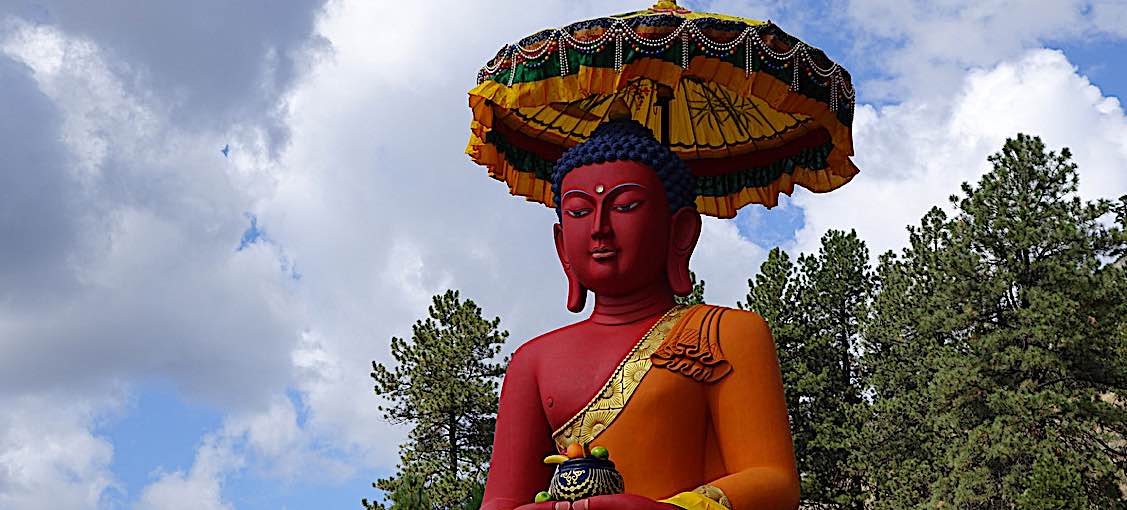
“When I have attained Buddhahood, if those beings who are in the ten quarters should believe in me with serene thoughts, and should wish to be born in my country, and should have, say, ten times thought of me (or repeated my name) – if they should not be born there, may I not obtain the perfect knowledge; – barring only those who have committed the five heinous crimes, and those who have spoken ill of the good Dharma.”
— Amitabha Sutra
“Namo Amitabha” is a praise chanted in different forms by millions — as a complete practice in itself. He is best known as the Buddha of Compassion. Sometimes he is called the “Buddha of infinite merits” and also “Buddha of Infinite Light.” Amitabha fulfils the “savior” role amongst the Buddhas (together with his spiritual children Avaolokiteshvara and Tara) — this because of his “great vow” in 48 points (see sutra below.) His actual name praise is, in full: “Om Namo Amitabhaya Buddhaya” in Sanskrit. (In Japanese, Namu Amida Butsu)
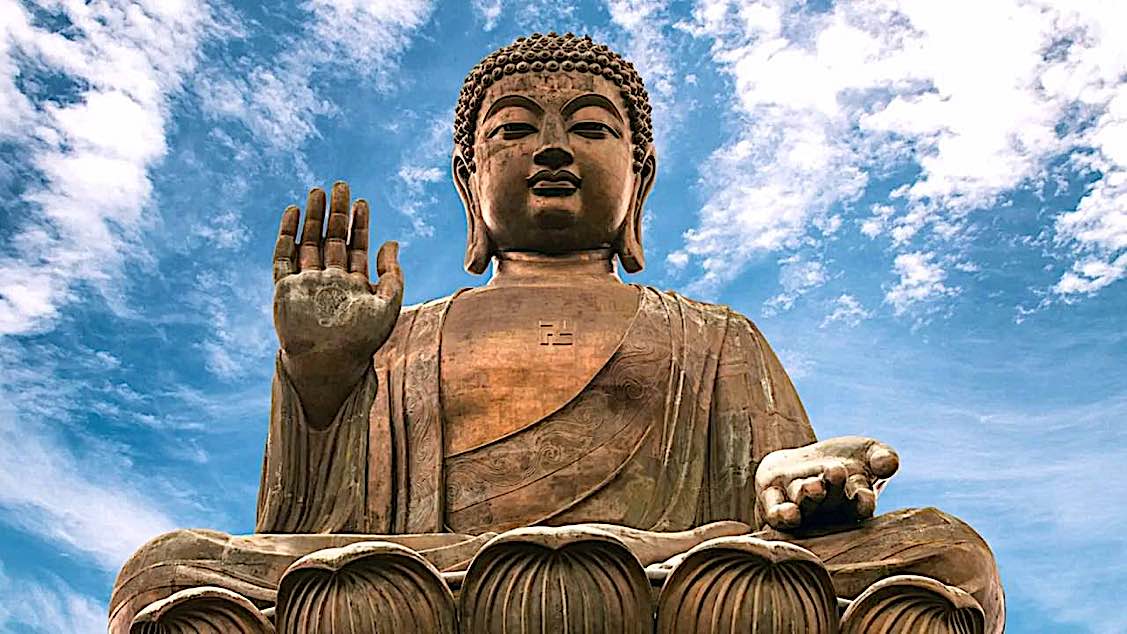 Amitabha Buddha.
Amitabha Buddha.
It is this role, as savior, and the simplicity of his vow and practice that empowers Pure Land practitioners. Pure Land Buddhism takes full refuge in Buddha Amitabha, and a primary practice is to praise his name. Some traditions, such as Jodo-shinshu have Amitabha as the sole deity. Yet, Amitabha is a major aspect of all traditions of Mahayana, loved by millions because of his vow and his limitless compassion.
One of his popular labels is is just “Western Buddha.” Amitabha is the warmth of the western red, setting sun — his name literally means “infinite light” — and he is the refuge of many millions of Buddhists. Gautama Buddha (Shakyamuni) is also associated with the west; some scholars directly relate Shakyamuni to Amitabha. [Note: the full shorter verison of the Amitabha Sutra is at the end of this feature.]
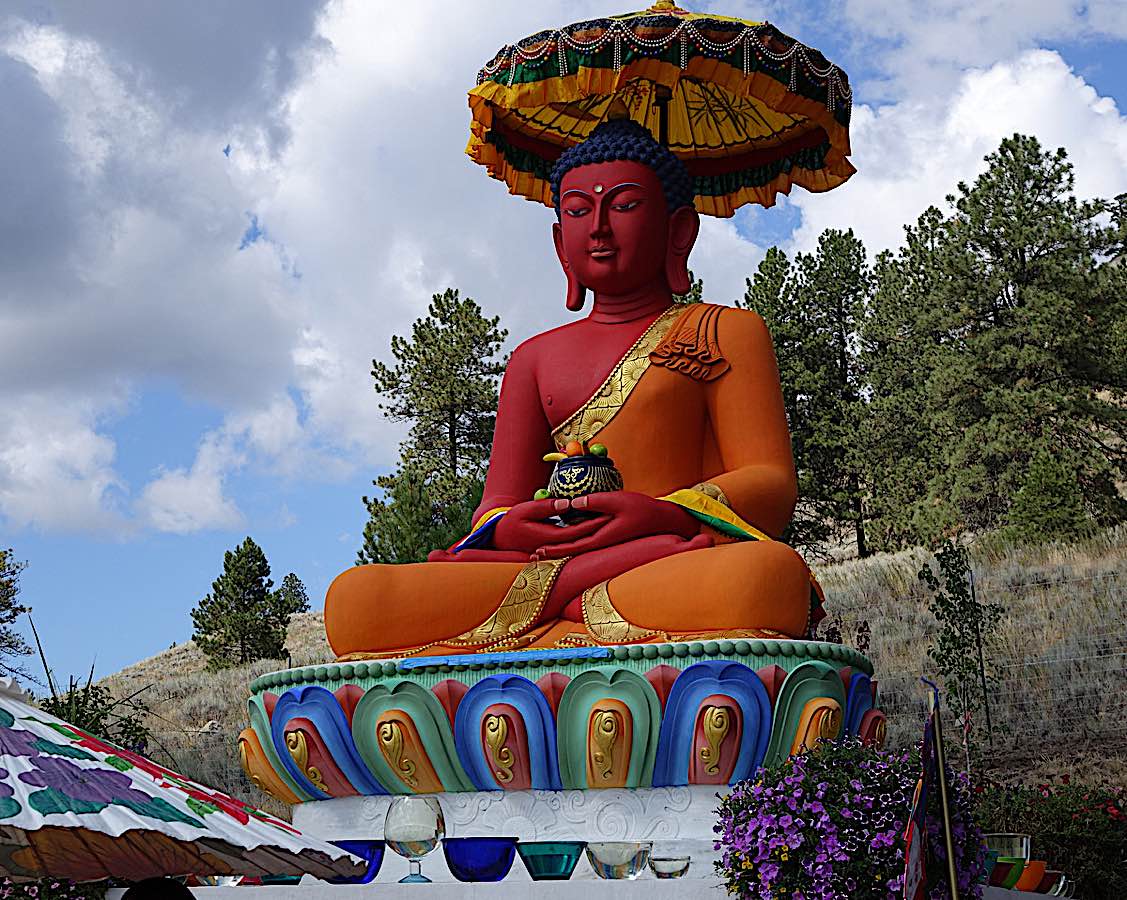 Amitabha Buddha is normally visulized as a glowing red body of light. Red symbolizes many things, including: the Padma (Lotus) family, fire, the west, magnetizing deity, Dharma and speech, and compassion/love. Picture from an FPMT centre.
Amitabha Buddha is normally visulized as a glowing red body of light. Red symbolizes many things, including: the Padma (Lotus) family, fire, the west, magnetizing deity, Dharma and speech, and compassion/love. Picture from an FPMT centre.
Amitabha: merits so vast, all can benefit
Not only is he practiced by nearly all Mahayana Buddhists, he is the most approachable Buddha for a new Buddhist to practice. In this life, we are conditioned to respond in kind to love and compassion — and Amitabha is the highest form of both. This is why his practitioners tend to display so much love and compassion and faith in Amitabha. Who doesn’t welcome compassion and love in their lives? Other Buddha forms might represent “wisdom” or “healing” or “protection”, but Amitabha is best known as “compassion” and “love.” Of course, Amitabha stands for wisdom, heals and protects — and other Buddhas are equally compassionate — but his “label” is defined by compassion. This was established in his great sutra vows.
His practice is easy and welcoming, and his merits are so vast that all beings can benefit. Everyone can identify with his role as the embodiment of “compassionate love.”
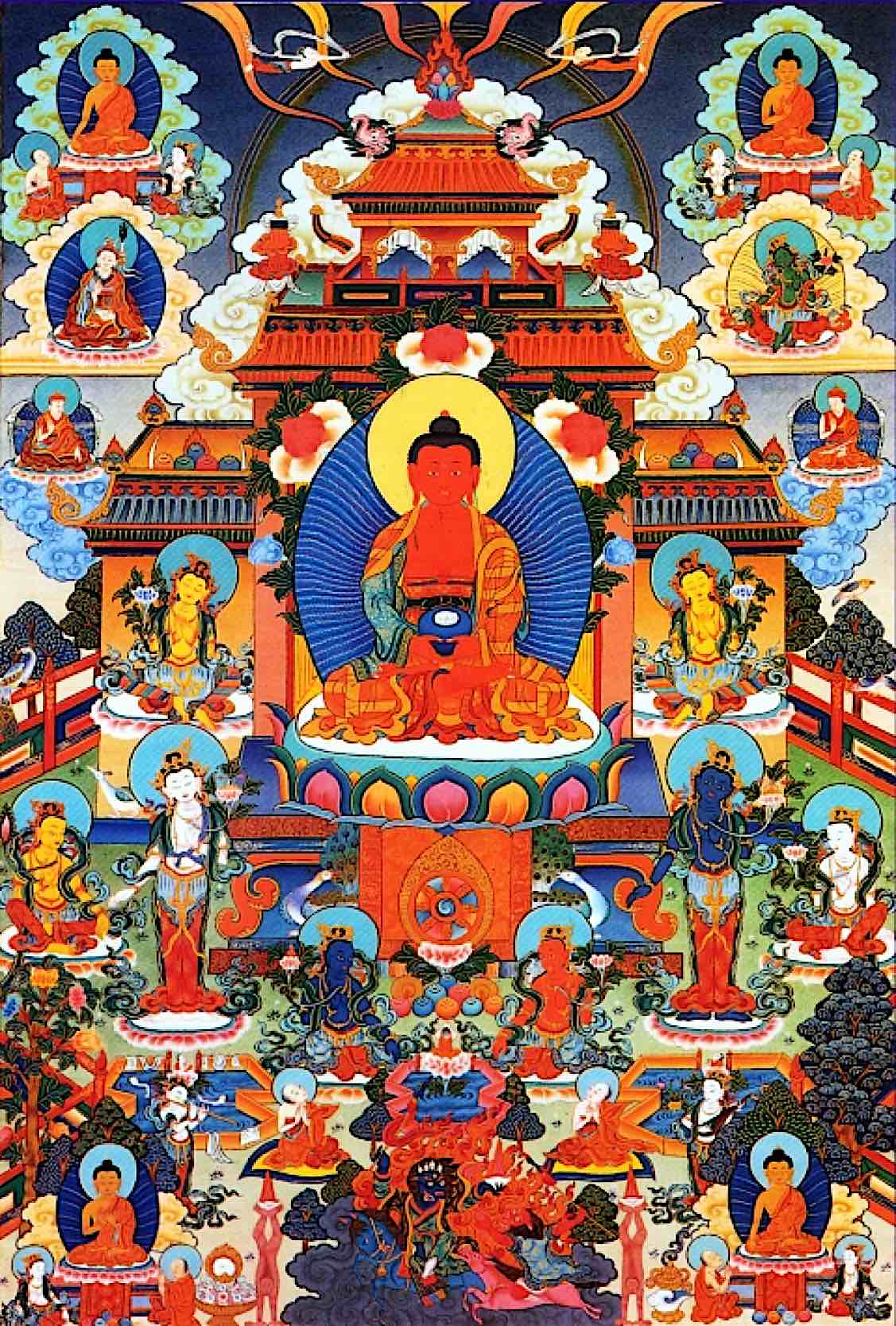 Amitabha is synonymous with Pureland Buddhism because of his great vow. (In this image, Amitabha and the other deities in his Pure Land.) His Pureland, Sukhavati, is where his followers hope to be reborn after death.
Amitabha is synonymous with Pureland Buddhism because of his great vow. (In this image, Amitabha and the other deities in his Pure Land.) His Pureland, Sukhavati, is where his followers hope to be reborn after death.
He is synonymous with Pure Land Buddhism, because, through his efforts (practice of eons) he created this happy pure land called Sukhavati (literally
 Amitabha as visualized in non-Tantric form.
Amitabha as visualized in non-Tantric form.meaning “possessing happiness.”) Because of his meritorious vow, anyone who calls out his name will be reborn into this happy paradise. In modern context, many people think of the pure land as a “mind state” — the peaceful mind of a realized being — rather than as a remote place.
The vow he made, in front of his own Guru (before he was Enlightened) — according to the Larger Sukhavati Vyuha Sutra — was:
“When I have attained Buddhahood, if those beings who are in the ten quarters should believe in me with serene thoughts, and should wish to be born in my country, and should have, say, ten times thought of me (or repeated my name) – if they should not be born there, may I not obtain the perfect knowledge; – barring only those who have committed the five heinous crimes, and those who have spoken ill of the good Dharma.”
The five heinous crimes that would exclude one from Amitabha’s pureland Sukhavati are:
Intenionally killing one’s own father. Intentionally killing one’s own mother. Killing an Arhat or Bodhisattva. Shedding the blood of a Buddha. Creating a schism within the Sangha (the community of Buddhists).Otherwise, the practice of calling out Amitabha Buddha’s name at least ten times (especially when dying) is a practice that helps lift our minds to the pure land of Sukhavati.
Amitabha, Lord of the Lotus Family
Amitabha (aka Amita, Amida, Amitayus) is Lord of the Lotus Family and the Sukhavati Pure Land — which literally can mean “happy land”. He is probably the best known of the Enlightened manifestations in Mahayana — aside from Shakyamuni Buddha himself. Amitabha is the primary Buddha in many Pure Land Buddhism schools, and is very important in Vajrayana and Tibetan Buddhism. Second only to Amitabha in popularity would be his spiritual son in the Lotus (Padma) family, Avalokiteshvara (or Guan Yin, Kuanyin, Kannon).
The Lotus (Padma in Sanskrit) family is associated with: west, red, magnetizing, lotus, the “wisdom of discernment”, overcoming the poison of desire and the skanda of perception, Dharma and speech, and fire.
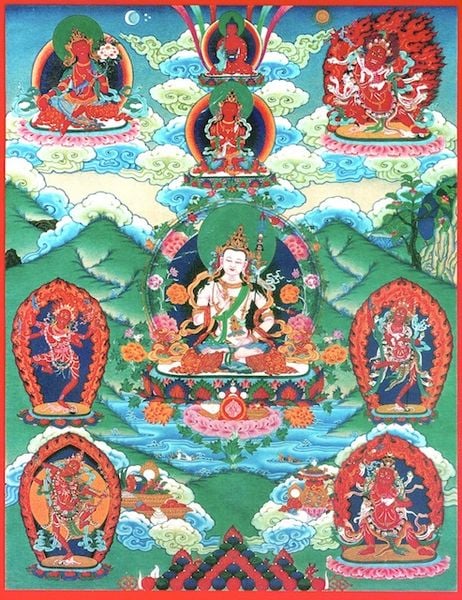 The nine magnetizing deities, from a supplication composed by Jamgön Mipham Gyatso in 1879. Top centre: Amitabha. The full list of magnetizing deities: Dharmakaya Amitabha, Vajradharma, Avalokiteshvara, Padmasambhava, Heruka Hayagriva, Guhyajnana (Vajrayogini), Vajravarahi, Mahadeva, and Kurukulla.
The nine magnetizing deities, from a supplication composed by Jamgön Mipham Gyatso in 1879. Top centre: Amitabha. The full list of magnetizing deities: Dharmakaya Amitabha, Vajradharma, Avalokiteshvara, Padmasambhava, Heruka Hayagriva, Guhyajnana (Vajrayogini), Vajravarahi, Mahadeva, and Kurukulla.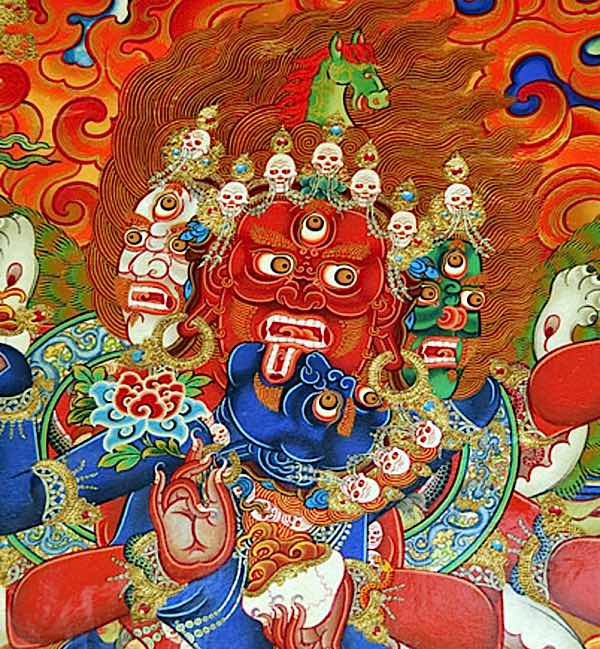 Hayagriva, Heruka aspect of Amitabha Buddha. Though he is wrathful, in fact considered the most wrathful of all deities due to his fiery nature, he still holds the lotus in his hand, emblemic of the Lotus (Padma) family.
Hayagriva, Heruka aspect of Amitabha Buddha. Though he is wrathful, in fact considered the most wrathful of all deities due to his fiery nature, he still holds the lotus in his hand, emblemic of the Lotus (Padma) family. The deities of the Padma family (also known as “magnetizing deities), under Amitabha’s gentle care are (with links to more detailed stories):
Amitayus (a form of Amitabha) “Infinite life” and long life instead of “infinite light” Pandaravasini (Amitabha’s precious wisdom consort) Avalokiteshvara (Chenrezig, Kuanyin, Guan Yin, Kannon) (More details on Avalokiteshvara here>>) White Tara (More details on White Tara here>>) Manjushri (the Buddha of Wisdom) is normally associated with Padma family Heruka Hayagriva (heroic or wrathful form of Amitabha) (More details on wrathful Hayagriva here>>) Vajrayayogini / Guhyajnana, the Secret Wisdom Deity (More details on Vajrayogini here>>) Vajradharma (a highest yoga Tantra deity representing Enlightened Speech) Padmasambhava (according to Tantra, he is an emanation of Amitabha and Avalokiteshvara) (See this story with teachings from the Lotus Born>>) Vajravarahi (Red Dakini queen) Kurukulla (sometimes spelled Kurukulle): an enlightened form of discerning wisdom, a fierce form of Tara Green Tara (She is actually part of Amoghisiddi’s Karma (action) family as consort, but she is an aspect/emanation of Avaolokiteshvara and her teacher is Amitabha, making her a member of “both” families: Padma and Karma). (More details on Green Tara here>>)Most of the red deities in Tantra are “magnetizing” deities and would be considered, at least, connected to the Padma Lotus family of Amitabha. For example, the practice of the Great Cloud of Blessings composed by Jamgön Mipham Gyatso in 1879 supplicates and honours most of the Buddhas listed above, specifically: Dharmakaya Amitabha, Vajradharma, Avalokiteshvara, Padmasambhava, Heruka Hayagriva, Guhyajnana (Vajrayogini), Vajravarahi, Mahadeva, and Kurukulla.
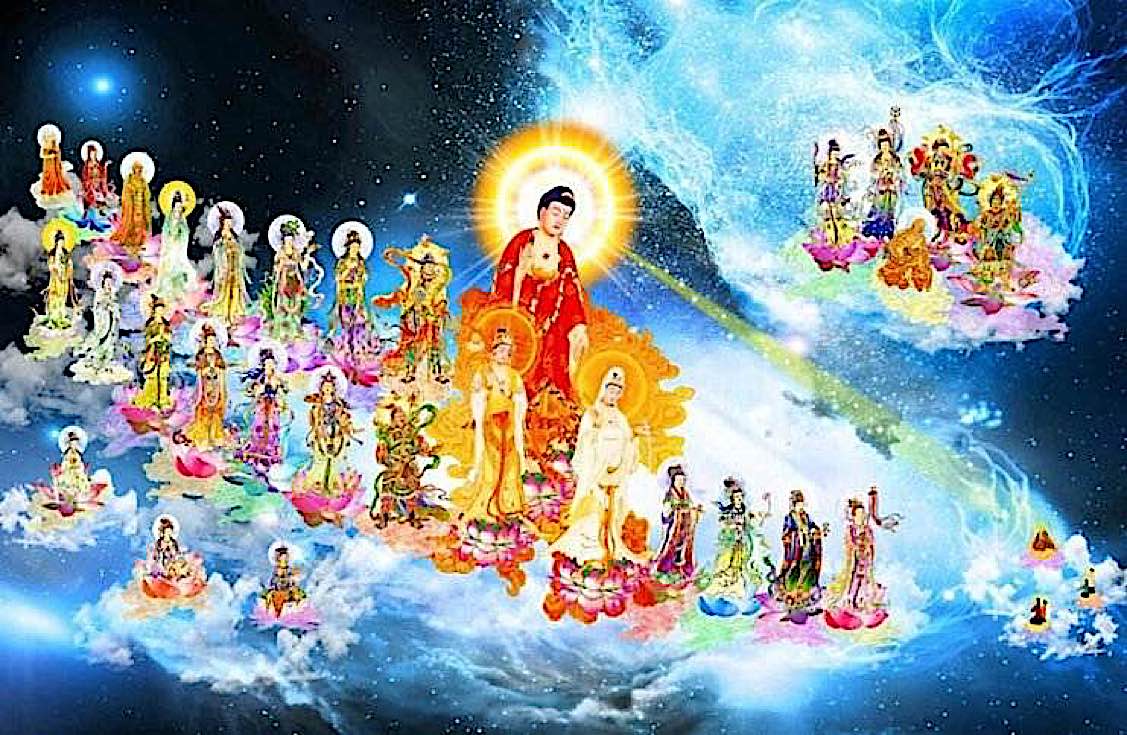 Amitabha in his pureland in the Chinese style.
Amitabha in his pureland in the Chinese style.
What’s in a name?: compassion and Dharma
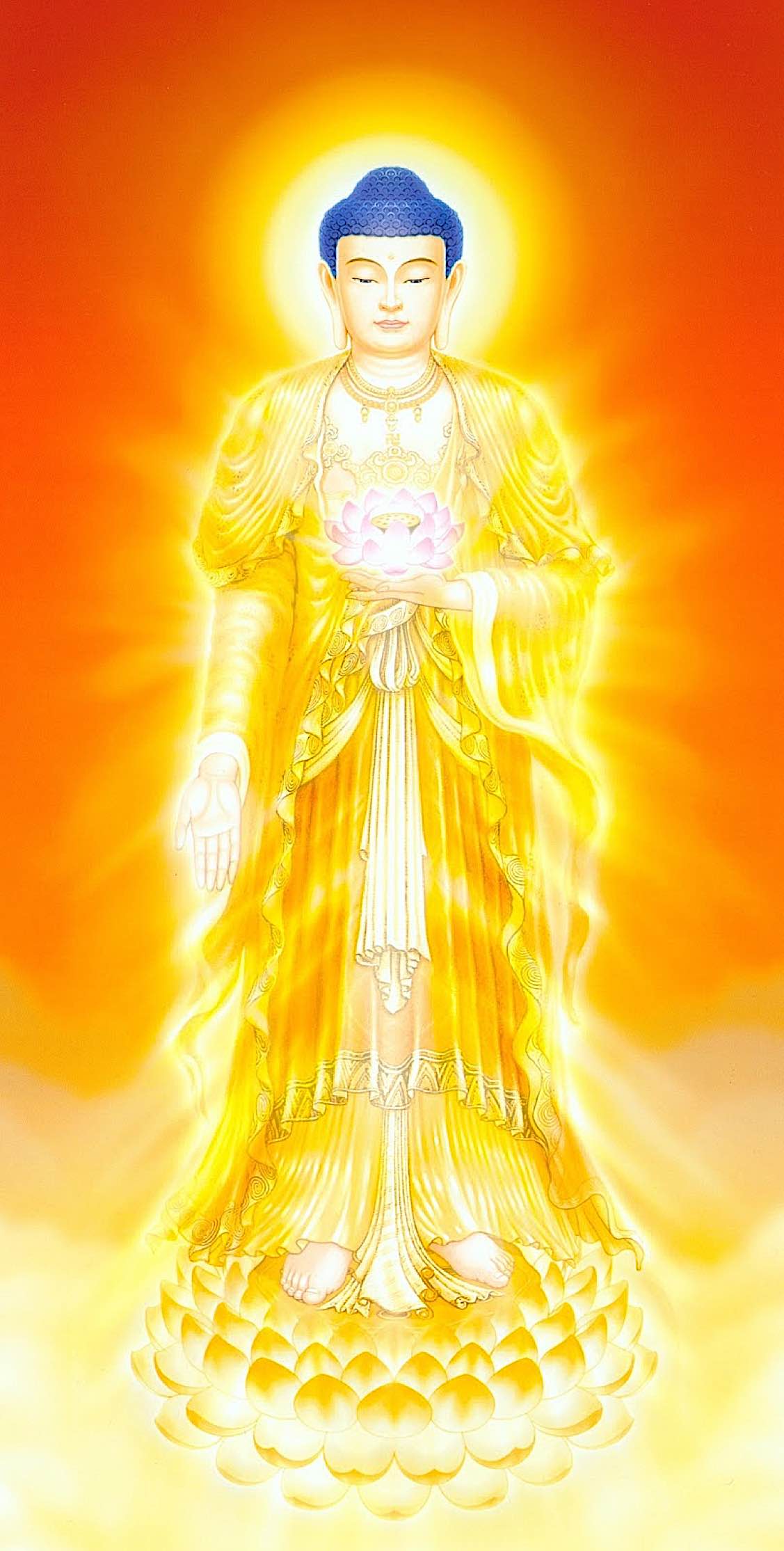 Amitabha.
Amitabha.Although all Buddhas have the same realizations and essence, the Padma family — the Lotus deities of the west — represent the speech and Dharma, and also the compassion of all the Buddhas. Of the three jewels — Buddha, Dharma and Sangha — the sutras indicate Dharma is the most important. The teachings help us progress on the Bodhisattva’s compassionate path to Enlightenment for the benefit of all beings.
Because of Amitabha’s infinite merits and compassion, simply calling out his name is enough to draw his infinite life. Repeated recitation of his name praise (known as nianfo in Chinese and nembutsu in Japanese) — or his mantras — can help his devotee be reborn in Sukhavati Pure Land. In different languages, these name praises (Romanized) are:
Namo Amitabhaya Buddhaya (pronounced Ah-me-tah-byah-ya) in Sanskrit Namo Emituofo in Mandarin Chinese Namo Amituofo in Cantonese Chinese Namu Amida Butsu in Japanese (in Jodo Shinzu, sometimes Na man da bu) Namu Amita Bul in KoreanWhy do some schools consider the name praise repetition a complete practice (aside from sutra instructions)? To get to the essence of why requires a full discussion of Emptiness and Dependent Origination and labels, which is fundamental Mahayana Buddhist understanding. For simplicity, until we Enlightenment, labels define qualities and have significant power (imprints) on our minds. If we label a car a Toyota, it becomes a Toyota; otherwise it is just a few thousand auto parts.
Calling out Amitabha’s name is to identify with and call out for the blessings of what that label signifies — Compassion, Infinite Merit, Virtue, Infinite Light, Dharma, Happiness in Sukhavati, Long life, and so on. But, not just “small c” compassion; Amitabha literally IS the Compassion of all the Buddhas — in essence, the compassion of the universe. We are connecting with universal Compassion, Happiness, and so on, not just a little one-on-one compassion.
What’s in an appearance?
Amitabha’s appearance, as we visualize him, reveals 84,000 auspicious marks and virtues — symbolic of his infinite virtues. He is among the most recognizable, similar to Shakyamuni in many aspects. He appears as a monk (in his main form) with huis hands in the meditation mudra: thumbs touching, fingers laid on top of each other. (Shakyamuni Buddha is normally similar, but normally shown with the “earth touching mudra”.)
In Vajrayana, or Tibetan Buddhism, Amitabha’s relationship with speech (Dharma), the west, and compassion are symbolized by the colour red. We would visualize this as a “body of red light” — not of flesh and bone. He can be visualized with or without his Wisdom Consort Pandaravasini. He is often visualized with hit two main disciples: Avalokiteshvara to the right (Buddha of Compassion) and Vajrapani to the left (Buddha of Power). The Panchen Lamas and the Shamarpas are considered to be emanations of Amitabha, in the same way the Dalai Lama is considered to be an emanation of Avalokiteshvara.
 Amitabha is associated with the west.
Amitabha is associated with the west.
Why Western Buddha?
Direction is typically a symbol, since Buddha’s do not exist singularly in a specific direction or place. As a symbol, Amitabha is associated with the West in all traditions. This is because his pure land is symbolically placed in the West — the land of happiness (Western Pureland named Sukhavati). Ancient tradition associated the passing of life into the west. Traditionally, when we die, if we practiced Amitabha, we would, depending on our karma, be born into this happy Western Pureland to continue our practice and receive teachings — or, we would be reborn. Also significant are the red colour of the western setting sun and other factors.
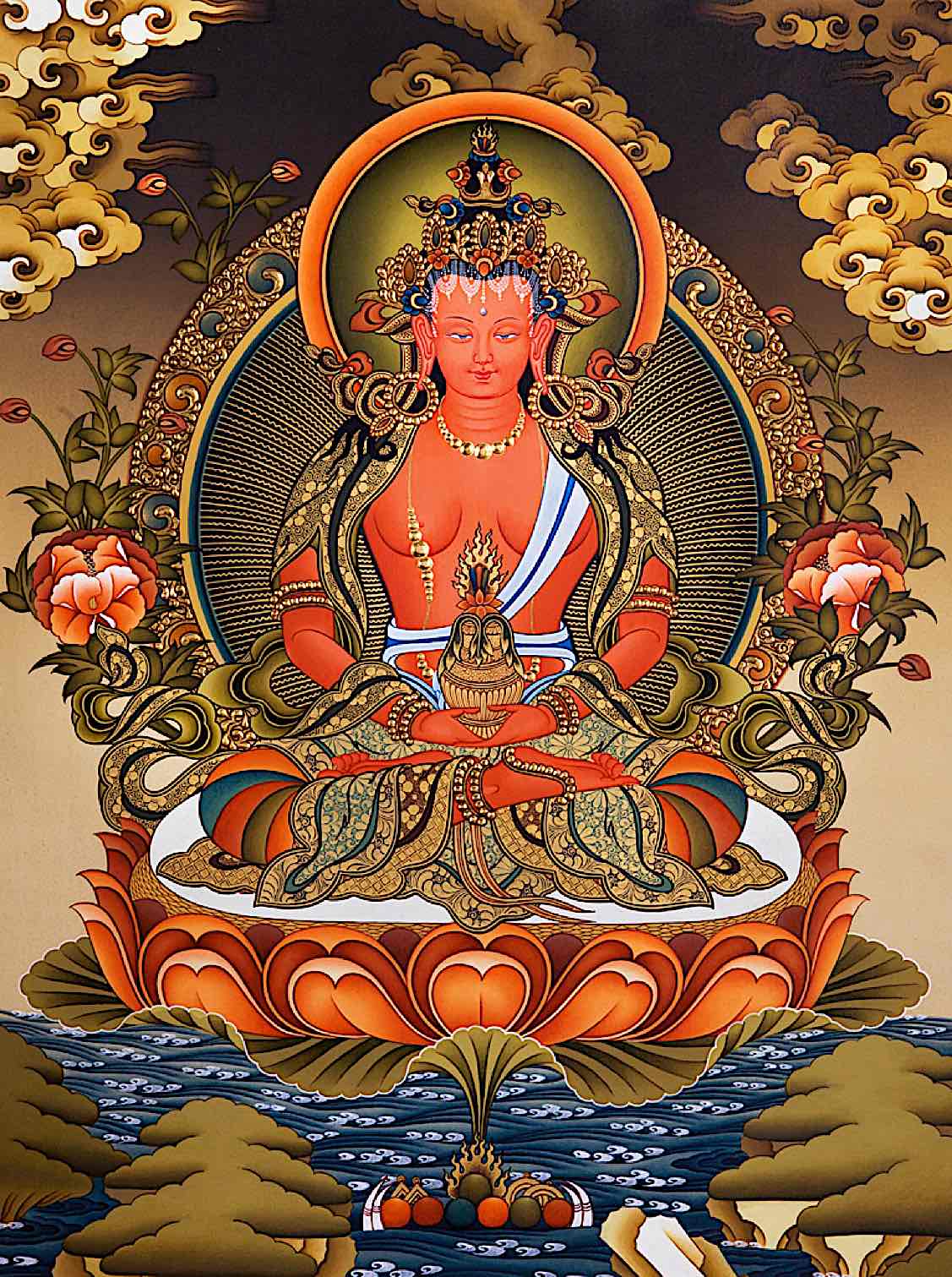 Amaitayus is a form of Amitabha. He is visualized in princely atire and crown (instead of a monk) and his practice is for “long life.” Amitayus translates as “Infinite Life.”
Amaitayus is a form of Amitabha. He is visualized in princely atire and crown (instead of a monk) and his practice is for “long life.” Amitayus translates as “Infinite Life.”
Mantra of Amitabha
His mantra is particularly effective — and those of any Lotus family deity — because they literally embody the “speech of all the Buddhas.” No initiation or empowerment or permission is needed to chant or benefit from this all-encompassing compassionate Buddha.
Beautiful chanting of Om Ami Dewa Hrih, the mantra of Amitabha:
His simple is often the first one given by Buddhist teachers. His main mantra, in Sanskrit, is:
Om Amitabha Hrih
Pronounced: Ohm Ah-me-tah-bah Hree (with the H “aspirated”)
In Tibetan this is often modified as:
Om Ami Deva Hrih
or
Om Ami Dewa Hrih
In Shingon Buddhism, the mantra is often chanted as:
On amirita teizei kara un
Also, the name praises, listed above, are mantric in nature, and can be chanted repetitively to invite the merit of Amitabha into your life.
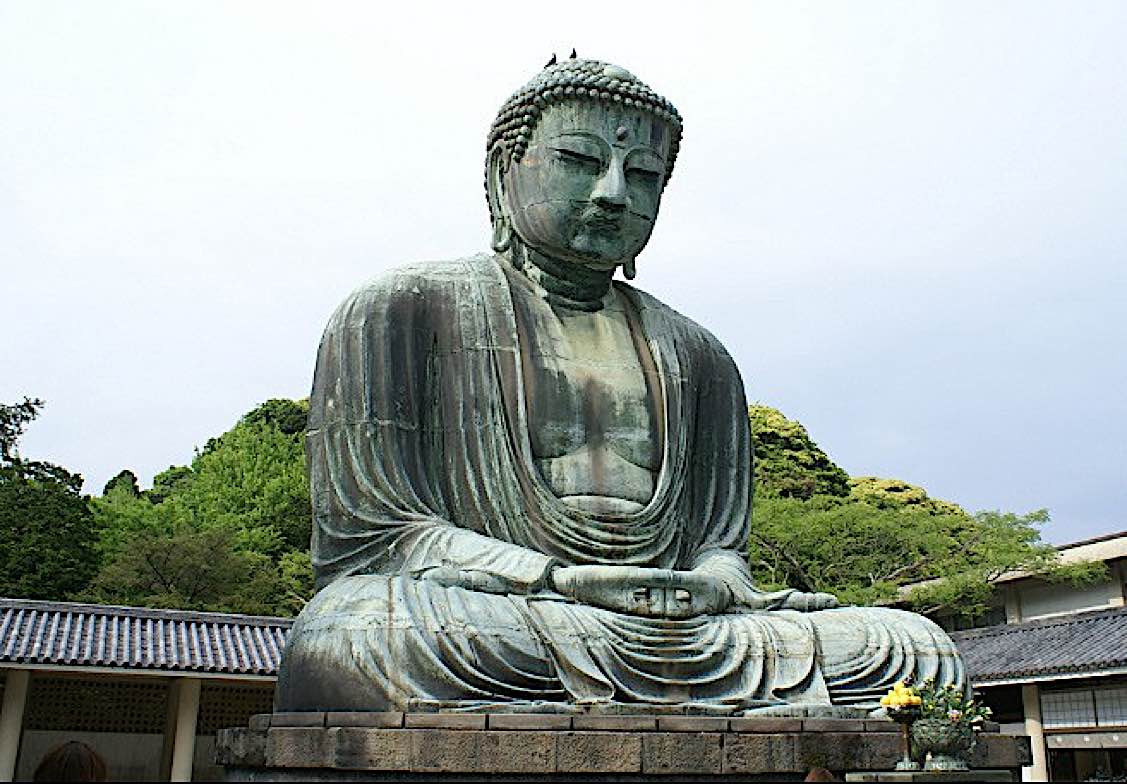 Statue of Amitabha.
Statue of Amitabha.
Practicing Amitabha
Although the name praise alone is a complete practice, if you wish to seriously engage in meditating on this meritorious and compassionate Buddha, a simple practice would include the necessary elements of Mahayana practice:
Refuge, stated out loud, such as: “I take refuge in the Three Jewels: Buddha, Dharma and Sangha” Bodhichitta aspiration, such as “I will attain Enlightenment for the benefit of all beings.” (Optionally) the Four Immeasurables: “ May all beings have happiness and the cause of happiness. May they be free of suffering and the cause of suffering. May they never be disassociated from the supreme happiness which is without suffering. May they remain in the boundless equanimity, free from both attachment to close ones and rejection of others.” Offering (not necessarily physical — your practice is an offering: or a simple candle, or bowl of water) (For more elaborate offerings see our story on Water Bowl offerings>> https://buddhaweekly.com/buddhist-water-bowl-offerings-as-an-antidote-to-attachment/ Visualize the Buddha as described above (or as given by your teacher) normally as a monk, seated in meditation, a body of red light. Chant the mantra (108 times is traditional) Dedicate the merit: “I dedicate the merit of this practice to the cause for enlightenment for all beings.” (For a video on why “dedicating merit” is critical, see>>)There are also very advanced practices, such as Powa, and Amitayus long-life practices, which do require guidance of a teacher and initiation.
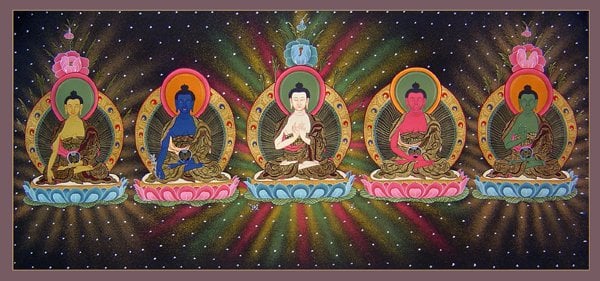 The Five Buddhas: from left to right Ratnasambhava (gold), Akshobya (blue), Vairochana (white), Amitabha (red), and Amoghisiddi (green).
The Five Buddhas: from left to right Ratnasambhava (gold), Akshobya (blue), Vairochana (white), Amitabha (red), and Amoghisiddi (green).
Dhyani Buddhas
In the cosmic world of deities, there are five Dhyani Buddhas, heading up five Buddha families (we’ve covered this in separate stories). The colour of the Buddhas is significant: white (body), red (speech), blue (mind), green (action or karma) — Amitabha and his family are red. Amitabha known as the Buddha of Discriminating Awareness Wisdoms. Amitabha is always associated with the west in all schools, although some of the other Dhyani Buddhas transpose from school-to-school based on symbolism and teachings. The five Dhyani Buddhas are:
Vairochana Amitabha Akshobhya Amoghisiddhi RatnasambhavaMeanwhile, in the more intensely visualized Vajrayana schools, Amitabha has countless manifestations, peaceful and wrathful. All of the “red” deities (the symbolic colour of the Lotus/Padma family) could be thought of as manifestations or emanations of Amitabha, including: Amitayas (Buddha of Infinite Life), Chenrezig (Avalokiteshvara) and all his emanations, Hayagriva (the most wrathful manifestation) and countless others. All of these emanations represent the compassion of the Lotus family, and also the Speech of the Buddhas (Dharma).
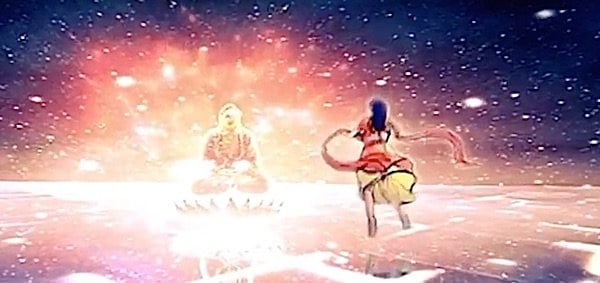 Amitabha, Buddha of Infinite light, appearing to a practitioner in dream form.
Amitabha, Buddha of Infinite light, appearing to a practitioner in dream form.
Sutra teachings
There are many sutras that mention Amitabha, and three canonical Mahayana sutras that focus on his doctrines and practice:
Infinite Life Sutra Amitabha Sutra (short version in full below) Amitayurdhyana SutraVideo animation of Buddha speaking the Amitabha Sutra with subtitles in English:
Amitabha Sutra
The smaller Sukhavati-Vyuha
Thus have I heard: Once the Buddha was dwelling in the Anathapindada Garden of Jetavana in the country of Shravasti together with a large company of Bhikshus of twelve hundred and fifty members. They were all great Arhats, well known among people, (to wit): Shariputra the elder, Mahamaudgalyayana, Mahakashyapa, Mahakatyayana, Mahakaushthila, Revata, Shuddhipanthaka, Nanda, Ananda, Rahula, Gavampati, Pindola-Bharadvaja, Kalodayin, Mahakapphina, Vakkula, Aniruddha, etc., all great Shravakas [lit. disciples]; and with many Bodhisattva-Mahasattvas, (such as), Manjushri, Prince of the Lord of Truth, Bodhisattva Ajita, Bodhisattva Gandhahastin, Bodhisattva Nityodyukta, etc., all great Bodhisattvas; and also with a large company of innumerable devas, (such as) Shakrodevanam-Indra, etc. Then the Buddha addressed Shariputra, the elder, and said, ‘Beyond a hundred thousand kotis of Buddha-lands westwards from here, there is a world named Sukhavati. In that world there is a Buddha, Amita(-ayus) by name, now dwelling and preaching the law. Shariputra, why is that country named Sukhavati? The living beings in that country have no pains, but receive pleasures only. Therefore, it is called Sukhavati. ‘Again, Shariputra, in the land Sukhavati (there are) seven rows of balustrades, seven rows of fine nets, and seven rows of arrayed trees; they are all of four gems and surround and enclose (the land). For this reason the land is called Sukhavati. ‘Again, Shariputra, in the land Sukhavati there are lakes of the seven gems, in which is filled water with the eight meritorious qualities. The lake-bases are strewn with golden sand, and the stairs of the four sides are made of gold, silver, beryl, and crystal. On land there are stories and galleries adorned with gold, silver, beryl, crystal, white coral, red pearl and diamond [lit. agate]. The lotus-flowers in the lakes, large as chariot wheels, are blue-colored with blue splendor, yellow-colored with yellow splendor, red-colored with red splendor, white-colored with white splendor, and (they are all) the most exquisite and purely fragrant. Shariputra, the land Sukhavati is arrayed with such good qualities and adornments. ‘Again, Shariputra, in that Buddha-land there are heavenly musical instruments always played on; gold is spread on the ground; and six times every day and night it showers Mandarava blossoms. Usually in the serene morning lit. dawn] all of those who live in that land fill their plates with those wonderful blossoms, and (go to) make offering to a hundred thousand kotis of Buddhas of other regions; and at the time of the meal they come back to their own country, and take their meal and have a walk. Shariputra, the Sukhavati land is arrayed with such good qualities and adornments. ‘And again, Shariputra, in that country there are always various wonderful birds of different colors, — swan, peacock, parrot, Chari, Kalavinka and the bird of double-heads [lit. double-lives]. Six times every day and night all those birds sing in melodious tune, and that tune proclaims the Five Virtues [lit. organs], the Five powers, the Seven Bodhi-paths, the Eight Noble Truths, and other laws of the kind. The living beings in that land, having heard that singing, all invoke the Buddha, invoke the Dharma, and invoke the Sangha. Shariputra, you should not think that these birds are in fact born as punishment for sin. What is the reason? (Because), in that Buddha-land there exist not the Three Evil Realms. Shariputra, in that Buddha-land there are not (to be heard) even the names of the Three Evil Realms. How could there be the realms themselves! All those birds are what Buddha Amitayus miraculously created with the desire to let them spread the voice of the Law. Shariputra, (when) in that Buddha-land a gentle breeze happens to blow, the precious trees in rows and the begemmed nets emit a delicate enrapturing tune, and it is just as if a hundred thousand musical instruments played at the same time. Everybody who hears that music naturally conceives the thought to invoke the Buddha, to invoke the Dharma, and to invoke the Sangha. Shariputra, that Buddha-land is arrayed with such good qualities and adornments. ‘Shariputra, what do you think in your mind, for what reason that Buddha is called Amita(-abha)? Shariputra, the light of that Buddha is boundless and shining without impediments all over the countries of the ten quarters. Therefore he is called Amita(-abha). Again, Shariputra, the life of that Buddha and of his people is endless and boundless in Asamkhya-kalpas, so he is named Amita(-ayus). Shariputra, since Buddha Amitayus attained Buddhahood, (it has passed) now ten Kalpas. Again, Shariputra, that Buddha has numerous Shravakas or disciples, who are all Arhats and whose number cannot be known by (ordinary) calculation. (The number of) Bodhisattvas (cannot be known) also. Shariputra, that Buddha-land is arrayed with such good qualities and adornments. ‘Again, Shariputra, the beings born in the land Sukhavati are all Avinivartaniya. Among them is a multitude of beings bound to one birth only; and their number, being extremely large, cannot be expressed by (ordinary) calculation. Only can it be mentioned in boundless Asamkhya-kalpas. Shariputra, the sentient beings who hear (this account) ought to put up their prayer that they may be born into that country; for they will be able to be in the same place together with those noble personages. Shariputra, by means of small good works [lit. roots] or virtues no one can be born in that country. ‘Shariputra, if there be a good man or a good woman, who, on hearing of Buddha Amitayus, keeps his name (in mind) with thoughts undisturbed for one day, two days, three days, four days, five days, six days, or seven days, that person, when about to die, (will see) Amitayus Buddha accompanied by his holy host appear before him; and immediately after his death, he with his mind undisturbed can be born into the Sukhavati land of Buddha Amitayus. Shariputra, as I witness this benefit, I say these words; Every being who listens to this preaching ought to offer up prayer with the desire to be born into that country. ‘Shariputra, as I now glorify the inconceivable excellences of Amitayus Buddha, there are also in the Eastern quarters Buddha Akshobhya, Buddha Merudhvaja, Buddha Mahameru, Buddha Meruprabhasa, Buddha Manjughosha, and Buddhas as many as the sands of the River Ganga, each of whom, in his own country stretching out his long broad tongue that covers three thousand greater worlds completely, proclaims these truthful words; All you sentient beings believe in this Sutra, which is approved and protected by all the Buddhas, and in which are glorified the inconceivable excellences (of Buddha Amitayus). ‘Shariputra, in the Southern worlds there are Buddha Candrasuryapradipa, Buddha Yacahprabha, Buddha Maharciskandha, Buddha Merupradipa, Buddha Anantavirya, and Buddhas as many as the sands of the River Ganga, each of whom, in his own country stretching out his long broad tongue that covers three thousand greater worlds completely, proclaims these truthful words: All you sentient beings believe in this Sutra, which is approved and protected by all the Buddhas, and in which are glorified the inconceivable excellences (of Buddha Amitayus). ‘Shariputra, in the Western worlds there are Buddha Amitayus, Buddha Amitalakshana, Buddha Amitadhvaja, Buddha Mahaprabha, Buddha Mahanirbhasa, Buddha Ratnala kshana, Buddha Shuddharashmiprabha, and Buddhas as many as the sands of the River Ganga, each of whom, in his own country stretching out his long broad tongue that covers three thousand greater worlds completely, proclaims these truthful words: All you sentient beings believe in this Sutra, which is approved and protected by all the Buddhas, and in which are glorified the inconceivable excellences (of Buddha Amitayus). ‘Shariputra, in the Northern worlds there are Buddha Arciskandha, Buddha Vaishvanaranirghosha, Buddha Dushpradharsha, Buddha Adityasambhava, Buddha Jaliniprabha, and Buddhas as many as the sands of the River Ganga, each of whom, in his own country stretching out his long broad tongue that covers three thousand greater worlds completely, proclaims these truthful words: All you sentient beings believe in this Sutra, which is approved and protected by all the Buddhas, and in which are glorified the inconceivable excellences (of Buddha Amitayus). ‘Shariputra, in the Nadir worlds there are Buddha Simha, Buddha Yacas, Buddha Yashaprabhava, Buddha Dharma, Buddha Dharmadhvaja, Buddha Dharmadhara, and Buddhas as many as the sands of the River Ganga, each of whom, in his own country stretching out his long broad tongue that covers three thousand greater worlds completely, proclaims these truthful words: All you sentient beings believe in this Sutra, which is approved and protected by all the Buddhas, and in which are glorified the inconceivable excellences (of Buddha Amitayus). ‘Shariputra, in the Zenith words there are Buddha Brahmaghosha, Buddha Nakshatraraja, Buddha Gandhottama, Buddha Gandhaprabhasa, Buddha Maharciskandha, Buddha Ratnakusumasampushpitagatra, Buddha Salendraraja, Buddha Ratnotpalashri, Buddha Sarvarthadarsha, Buddha Sumerukalpa, and Buddhas as many as the sands of the River Ganges^1, each of whom, in his own country stretching out his long broad tongue that covers three thousand greater worlds completely, proclaims these truthful words: All you sentient beings believe in this Sutra, which is approved and protected by all the Buddhas, and in which are glorified the inconceivable excellences (of Buddha Amitayus). ‘Shariputra, what do you think in your mind, why it is called the Sutra approved and protected by all the Buddhas? Shariputra, if there be a good man or a good woman who listens to those Buddhas’ invocation of the name (of Buddha Amitayus) and the name of this Sutra, that good man or woman will be protected by all the Buddhas and never fail to attain Anuttara-samyaksambodhi. For this reason, Shariputra, all of you should believe in my words and in what all the Buddhas proclaim. Shariputra, if there are men who have already made, are now making, or shall make, prayer with the desire to be born in the land of Buddha Amitayus, they never fail to attain Anuttara-samyaksambodhi, and have been born, are now being born, or shall be born in that country. Therefore, Shariputra, a good man or good woman who has the faith ought to offer up prayers to be born in that land. ‘Shariputra, as I am now praising the inconceivable excellences of those Buddhas, so all those Buddhas are magnifying the inconceivable excellences of myself, saying these words: Shakyamuni, the Buddha, has successfully achieved a rare thing of extreme difficulty; he has attained Anuttara-samyaksambodhi in the Saha world in the evil period of five corruptions — Corruption of Kalpa, Corruption of Belief, Corruption of Passions, Corruption of Living Beings, and Corruption of Life; and for the sake of all the sentient beings he is preaching the Law which is not easy to accept. Shariputra, you must see that in the midst of this evil world of five corruptions I have achieved this difficult thing of attaining Anuttara-samyaksambodhi, and for the benefit of all the beings I am preaching the Law which is difficult to be accepted. This is how it is esteemed as (a thing of) extreme difficulty.’The Buddha having preached this Sutra, Shariputra and Bhikshus, and Devas, men, Asuras, etc., of all the worlds, who have listened to the Buddha’s preaching, believed and accepted with joy, made worship, and went away.

 Tekef
Tekef 































